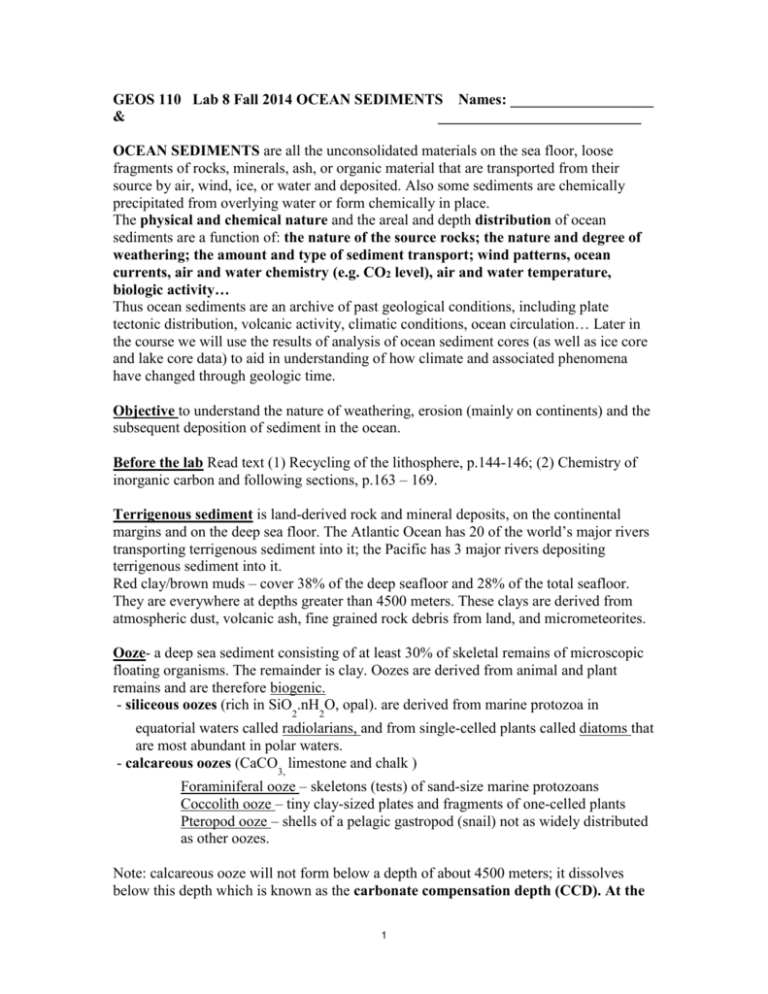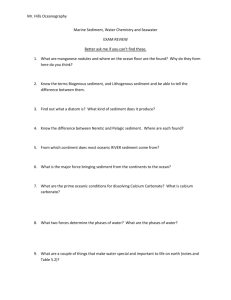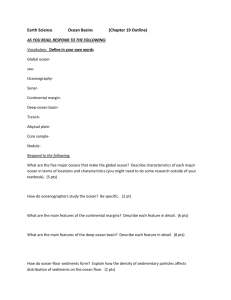Lab 8- OCEAN SEDIMENTS._F14doc
advertisement

GEOS 110 Lab 8 Fall 2014 OCEAN SEDIMENTS Names: ___________________ & ___________________________ OCEAN SEDIMENTS are all the unconsolidated materials on the sea floor, loose fragments of rocks, minerals, ash, or organic material that are transported from their source by air, wind, ice, or water and deposited. Also some sediments are chemically precipitated from overlying water or form chemically in place. The physical and chemical nature and the areal and depth distribution of ocean sediments are a function of: the nature of the source rocks; the nature and degree of weathering; the amount and type of sediment transport; wind patterns, ocean currents, air and water chemistry (e.g. CO2 level), air and water temperature, biologic activity… Thus ocean sediments are an archive of past geological conditions, including plate tectonic distribution, volcanic activity, climatic conditions, ocean circulation… Later in the course we will use the results of analysis of ocean sediment cores (as well as ice core and lake core data) to aid in understanding of how climate and associated phenomena have changed through geologic time. Objective to understand the nature of weathering, erosion (mainly on continents) and the subsequent deposition of sediment in the ocean. Before the lab Read text (1) Recycling of the lithosphere, p.144-146; (2) Chemistry of inorganic carbon and following sections, p.163 – 169. Terrigenous sediment is land-derived rock and mineral deposits, on the continental margins and on the deep sea floor. The Atlantic Ocean has 20 of the world’s major rivers transporting terrigenous sediment into it; the Pacific has 3 major rivers depositing terrigenous sediment into it. Red clay/brown muds – cover 38% of the deep seafloor and 28% of the total seafloor. They are everywhere at depths greater than 4500 meters. These clays are derived from atmospheric dust, volcanic ash, fine grained rock debris from land, and micrometeorites. Ooze- a deep sea sediment consisting of at least 30% of skeletal remains of microscopic floating organisms. The remainder is clay. Oozes are derived from animal and plant remains and are therefore biogenic. - siliceous oozes (rich in SiO2.nH2O, opal). are derived from marine protozoa in equatorial waters called radiolarians, and from single-celled plants called diatoms that are most abundant in polar waters. - calcareous oozes (CaCO3, limestone and chalk ) Foraminiferal ooze – skeletons (tests) of sand-size marine protozoans Coccolith ooze – tiny clay-sized plates and fragments of one-celled plants Pteropod ooze – shells of a pelagic gastropod (snail) not as widely distributed as other oozes. Note: calcareous ooze will not form below a depth of about 4500 meters; it dissolves below this depth which is known as the carbonate compensation depth (CCD). At the 1 CCD there is a chemical balance at which the dissolution rate of carbonate (CO32- ) ion equals the supply rate. Contributing to the dissolution of carbonate is the corrosiveness of seawater, which increases as temperature decreases, pressure increases, carbonate-ion content decreases, and dissolved carbon dioxide increases. The Pacific generally has a shallower CCD than the Atlantic or Indian Oceans because of its greater carbon dioxide content (colder carbon dioxide rich Antarctic Bottom Water flows into the Pacific). Manganese nodules: form where other sedimentation is very slow, as in the red clay areas of the abyssal plain. Nodules of manganese grow particle by particle on a nucleus of skeletal material or mineral matter. They are hydrogenous because the manganese chemically precipitates from solution in seawater. Nodules are estimated to cover 10% of the deep ocean floor. Questions 1. Look at Figure 3.4. On the profile of line AB (Figure 3.4) by the elongate boxed labels, indicate what sediment type one would predictably encounter on the sea floor. Use symbols provided. Exposed basalt (young) with no sediment covering: bbb. Terrigenous sediments: +++ Red Clays: :: Siliceous oozes: ~~ Calcareous oozes: «« Manganese nodules: ●●● The map vertical scale is in fathoms. With respect to the CCD and location of calcareous oozes, note that there are 6 feet/fathom; 1.83 meters/fathom. 2. Core data and map analysis Exploratory Ocean Drilling has recovered cores from two different oceans: 9 cores were drilled to sample Ocean A and 7 to sample Ocean B. A map of the hypothetical oceans is shown. Think about the plate tectonic environments. The drilling log below describes the sediments and rocks recovered from drilling core samples at various depths in each ocean. Included in the description is the length (meters) of sediment recovery. 2 3 4 Working up core log data. a. On the graph paper (Figure 2 on the next page) plot the data for percentage calcium carbonate from the table above versus depth for cores 1-16. Use a dot for each sample for Ocean A and a star for each sample for Ocean B (do not connect the dots). If there is no CaCO3 value, do not plot. b. Why is there a sharp reduction in calcium carbonate below a certain depth in both oceans? 5 Figure 2 – Graph of percentage calcium carbonate vs depth Depth 1000 2000 3000 4000 5000 6000 7000 0 30 percent calcium carbonate Figure 3 – Depth profile of cores Core 1 2 3 4 5 6 0m 7 8 9 10 60 11 12 90 13 14 15 16 1000 2000 3000 4000 5000 6000 7000 c. On the graph above, plot a depth profile of each line of cores in Ocean A and Ocean B. Use colored pencils to indicate the dominant sediment type in each core. Use Red for clays, Blue for oozes, Yellow for sand-silt-terrigenous clays, and Black for volcanic rock or basalt. 6 d. Why does the nature of the sediments change from the deep ocean toward the continent? e. Why are there no red clays indicated in the Ocean B profile? Hint: consider the map/drawing of Ocean A and B with respect to terrigenous sediment sources as well as passive and active continental margin features. . f. In core 5, how do you explain the presence of calcareous ooze below the red clay? . g. If there were sands in core 14 in Ocean B at 3,000 meters in depth, but none in core 3 in Ocean A at 3,000 meters depth, suggest a reason for this difference. h. If red clay on the deep-sea floor accumulates at an average rate of about 1 millimeter per 1,000 years, and ooze accumulates at a rate ten times faster, how much time would be required to deposit 25mm of red clay? Show your work. i. How many years would a core 10 meters in length represent if it contained 5 meters of ooze and 5 meters of red clay? Show your work. (1 meter =1,000 millimeters). 7






